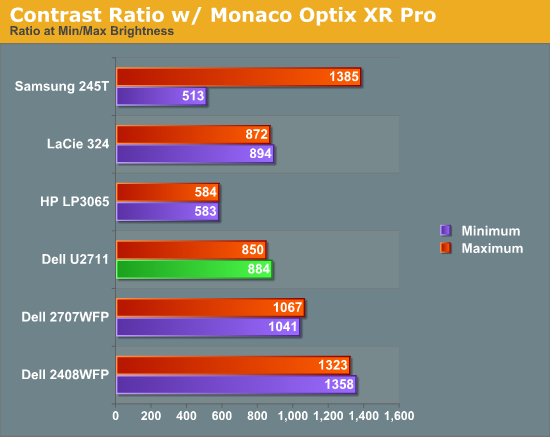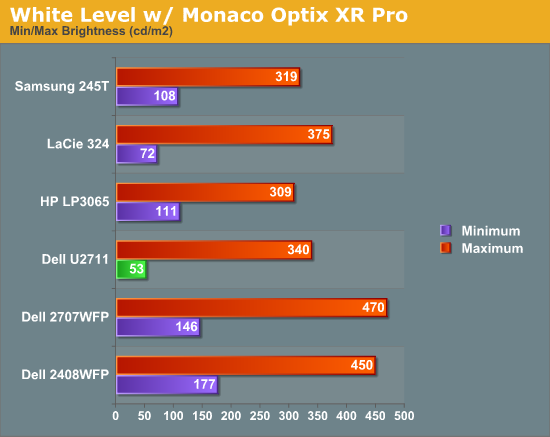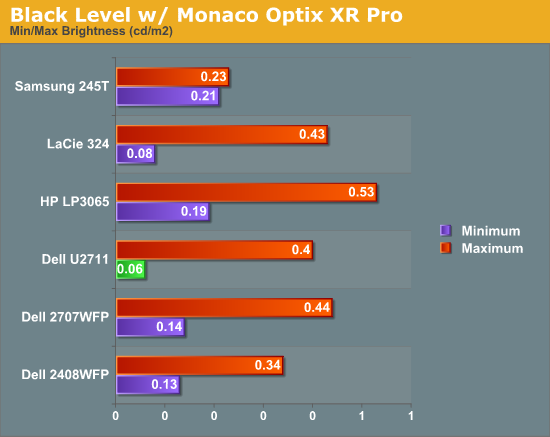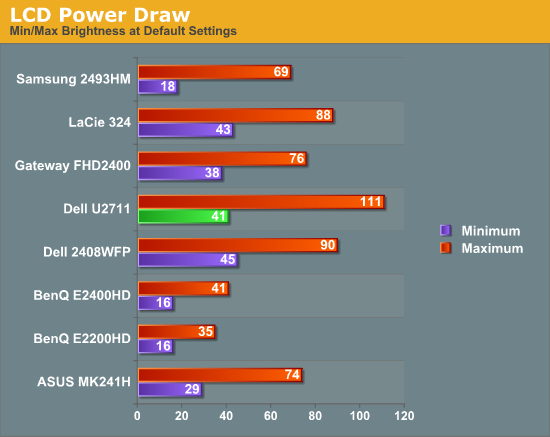Dell UltraSharp U2711: Quality has a Price
by Jarred Walton on January 22, 2010 2:00 AM EST- Posted in
- Displays
Brightness and Contrast
For the brightness, contrast, and color accuracy tests, we depend on a hardware colorimeter and software to help calibrate the displays. We use a Monaco Optix XR (DTP-94) colorimeter and Monaco Optix XR Pro software. Dell advertises a typical contrast ratio of 1000:1 and a maximum contrast (using dynamic backlight adjustment) of 80000:1. We're not interested in dynamic contrast, so we used the Adobe RGB setting for the results below. For those that are wondering, the reason we don't like dynamic contrast is that CCFL backlights take time to settle in and provide a consistent output, and if a display is constantly modifying the backlight level you won't get accurate colors.



Don't pay too much attention to the white/black graphs, as they are merely reference points for how the displays perform at certain settings. Like many other LCDs, the U2711 has a "normal" brightness level of around 260nits (the Adobe RBS setting defaults to 50% brightness and contrast), which is more than sufficient and is actually brighter than what most users prefer to use in an office environment. You can reach the advertised 350nits (give or take) if you max out brightness and contrast.
We're more interested in the contrast ratio, and here we find that the U2711 doesn't quite reach the advertised 1000:1 but instead comes closer to 850:1. We would have liked to see black levels a bit lower to improve the contrast, but really anywhere above 750:1 is difficult to see the difference, and 500:1 is sufficient for most users. At lower brightness settings, the contrast ratio improves to the point where our 100nits "print" result (~13% brightness) actually reached the advertised 1000:1 contrast ratio.
Power Requirements
Going along with the brightness levels, here are the power requirements we measured at the Windows desktop using the minimum brightness (53nits) setting along with 100nits (13%), 200nits (36%), and maximum brightness (340nits).

This is another area where we think the U2711 could be improved, but the cost might be too high right now. CCFL backlighting has been the norm since LCDs first came out, and it works but it's not the most power efficient way of lighting up an LCD. LEDs are the new and improved method, but while they can save power they also tend to deliver a lower color gamut. RGB LEDs address that shortcoming but they cost more and appear to use a similar amount of power compared to CCFL (and we've only seen them used in laptops so far). The U2711 draws a minimum of 41W, but a more realistic setting of 200nits will pull 72W. At maximum brightness the display settles down to 111W, but we measured a peak draw of 124W. (When we first cranked up brightness from 36% to 100%, brightness also reached 390nits before declining to 340nits.) We'd like to see LCDs that deliver all the color quality at half the power draw, but right now it's more a question of priorities: if you go green on power, your green colors may end up lacking. And to keep things in perspective, 72W at 200nits for a 27" LCD is still about half the power of your typical 21/22" CRT running at ~200nits!










153 Comments
View All Comments
ninjackn - Friday, January 22, 2010 - link
The color gamut issues stems from issues with applications not using ICC profiles. It was a huge problem in windows XP because so few applications cared to use color profiles. It's gotten a lot better with windows vista/7 (or with OSX) but it still pops up from time to time, specifically with all those images on the web missing color information.Here's a website that shows what i'm talking about:
http://www.gballard.net/psd/go_live_page_profile/e...">http://www.gballard.net/psd/go_live_page_profile/e...
JarredWalton - Friday, January 22, 2010 - link
Okay, I read through that, tried it on Firefox 3.5.7, IE8, and Safari 4. I get the problem now... it's not having a wide color gamut LCD, but rather viewing images that have an ICC profile in applications that don't respect those profiles, right?In terms of internet publishing, I'd have to agree that we need to standardize, and since sRGB is already the standard there's no point in going elsewhere. For an imaging professional where the content isn't going on the web, though, wouldn't you want the better color space? I always "save for web" if I'm going to post an image online, and that strips out any ICC profile information (AFAIK).
I need to go play with this on the U2711 with and without a monitor profile (and using sRGB and Adobe RGB) to see what effect - if any - it has on the experience. Stay tuned....
CSMR - Friday, January 22, 2010 - link
Save for web should give an sRGB label and does with Photoshop CS3. No point in stipping it out.FF is color managed. As soon as IE becomes color-managed it will be fine to use any color spaces in web images. Microsoft has been fairly good about color management of late, so hopefully in IE9, fingers crossed.
velis - Friday, January 22, 2010 - link
To me, this monitor is more interesting from a different viewpoint:It's one of the rare few monitors that offer 2560 resolution at less than 30" size. And even this one only has 109 DPI resolution.
If this monitor was 22 - 24" in size, I'd buy it without second thought.
Of course you need to run Word at 150% magnification, but the fonts look just awesome with so many pixels available to render them. Not to mention games. A "fairly powerful" graphics card is needed though.
The only problem is that current display managers, be it Windows or Linux are all still raster ones and can't really adapt well to increased DPI displays.
Perhaps if more monitors like this would show up on the market, MS and Linux gurus would finally develop true vector user interfaces. Then we could have 150, 200 and even more DPI displays. I'm wondering how many more years before displays catch up to what printers had some 20 years ago already.
CSMR - Friday, January 22, 2010 - link
High dpi is very useable, even with normal pixel pitches 120dpi can be a good option. But yes vector graphics would make the benefit of higher dpi displays even greater.There is vector support in WPF since Vista so Windows is getting there at least.
Plus modern applications (including OS) tend to have raster graphics at various dpis, I think often including 150, so that is improving even without vector graphics.
But the fact is most people don't need very high dpi so we have to wait for the cost to come down. Also for displayport to become common once dvi reaches its limit and that will take a while.
dasgib - Friday, January 22, 2010 - link
I'm really curious about to know if the matte displays of the U2711 has the known "anti-glare effect" which many people complain about on 24" IPS monitors (like the HP LP2475w and Dell U2410)?I don't like glossy displays (as most people do), but I had to send the stated HP display back because of that anti-glare effect.
MadMan007 - Friday, January 22, 2010 - link
I have the HP and it's not bad as far as anti-glare coating although not the best I've seen - that would be a Samsung but sadly it was TN. It helps to sit a reasonable distance away, like a mere 2 feet or more. Every single Dell I've seen is far worse in terms of grainy anti-glare which is a shame because it means I can't consider Dell monitors at all, it just drives me too crazy to see whites all sandy-sparkly-grainy. It really makes me wonder how more Dell users don't even notice it at all.Maybe they've gotten better though? I'd sure like to know.
dasgib - Friday, January 22, 2010 - link
I just asked Jarred about this via email. Hopefully we get an answer soon :)JarredWalton - Friday, January 22, 2010 - link
I haven't noticed any negative effects from the anti-glare coating. I use a Dell 3007WFP normally and haven't ever noticed a problem there either. Mostly, I see the "grainy effect" on cheap TN panels, but maybe I'm just one of those people that isn't bothered by what you're referring to. Anyway, FWIW I feel the U2711 has the same appearance as the 3007WFP and I enjoy the picture. I don't notice "more graininess" or anything like that.MadMan007 - Friday, January 22, 2010 - link
There may be some confusion here over the word 'graininess.' It is not a screen-door effect, pixel pitch by-product or defect in the actual image. It is the screen coating itself - it's not 'grainy' per se in the way a film might be grainy, it's 'sparkly' is my best word for it. Another way to describe it is if you took some sand and lightly dusted the screen surface with it - the image itself looks fine but there's always this layer above it that has its own effect on the image. It makes things 'sparkly' -tiny random dots of coloration across the specturm. For some people it may blend together, I don't know, but I can't see how it's possible to miss entirely. Dell's anti-glare is known to be heavby and particularly prone to this effect which is why it's brought up. Check out forum threads about Dell monitors and you'll find plenty of people noting it.Now someone who uses a Dell monitor all the time may get used to it especially if they never have another monitor next to it. But Jarred you surely have seen a variety of screens. Have you ever set them up side-by-side with your Dell? What about a laptop screen if you have one? Or if you have access to a glossy screen at least to compare, they by nature will not have any anti-glare coating problem.